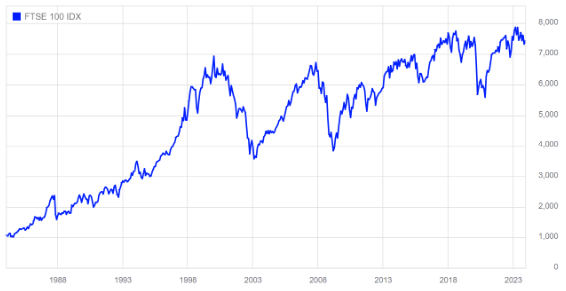9 November 2023
Investment risk and volatility: How to spot the difference now
;)
The last three years have been especially volatile for financial markets. In March 2020, the BBC reported that the coronavirus pandemic had resulted in the FTSE 100’s worst day in more than 30 years and the third worst on record.
Since then, markets have fluctuated due to Russia’s invasion of Ukraine, rising fuel bills, soaring inflation, and the cost of living crisis. UK markets also suffered the fallout from September 2022’s disastrous mini-Budget. Even bonds, traditionally considered a lower-risk option, have fared poorly.
The important question for you, though, is what does this volatility have to do with my investments and my level of investment risk?
Keep reading to find out.
Risk versus volatility in your investments
It’s important to remember that volatility and risk are not interchangeable investment terms. As an investor, creating a firm distinction between the two can be helpful, especially when times are hard.
Volatility
Volatility is defined as a “liability to change rapidly and unpredictably, especially for the worse” but this doesn’t mean that all volatility is bad news.
You might find that the price of your stocks or shares are particularly volatile at the moment, moving up and down rapidly, but still generally rising over the long term.
As long as you are not near the end of your investment term – and so looking to sell soon – volatility isn’t a problem. In fact, it can be a good thing, helping you to increase your investment fund by buying shares at lower prices. This also means your value will be higher when the markets recover and prices begin to rise.
Knowing how to cope with volatility is a crucial part of your investment strategy. And that usually means keeping calm and staying focused on your goals.
Risk
Risk, on the other hand, should be factored in, and you must understand the level of risk you are willing and can afford to take.
The risk inherent in your strategy is linked to the likelihood of achieving your long-term goals and meeting your financial commitments, both now and in the future. If you have a goal to retire at a certain age but you take undue risk, that dream might become unattainable.
You need to think carefully about your attitude to risk and how your goals and timescales tie into this. Also, consider your capacity for loss. You’ll want to be able to focus on your long-term goal while knowing that you are financially secure in the present.
Your risk profile is allowed to change if your long-term goals or priorities do, but your risk levels shouldn’t fluctuate in line with volatility.
We can help you to think about the interplay of risk and volatility in your portfolio, offering reassurance when times are bad, and helping you to avoid overconfidence when times improve.
3 key lessons for coping with risk and volatility
1. Remember that volatility is inevitable
The first investment lesson to learn is that market fluctuations and periods of volatility are to be expected and accepted.
We’ve already looked at the markets post-Covid, but other economic and geo-political events have also taken their toll. These include the 2008 global financial crisis and the Iraq War, for example.
It is for this reason that your investing time frames are long term. It gives your money time to ride out periods of short-term volatility and to grow as markets inevitably recover.
Remember the old investment adage: it’s time in the market, not timing the market.

Source: London Stock Exchange
Even a glance at the FTSE 100 over the last 40 years shows the generally upward trend of the market, alongside the numerous dips and volatile periods we’ve spoken about.
2. Diversification and asset allocation
Market volatility is likely to hit different asset classes, sectors, and geographical regions at different times. This is why your investment is diversified across these areas.
We diversify your portfolio to spread risk, in the hope that a drop in one area will be outweighed by a rise in another. This is one of the reasons why a 5% drop in a specific index or industry won’t automatically result in a 5% drop in the value of your portfolio.
By keeping a close eye on your level of diversification, and your asset allocation, we ensure your investment remains on track. We can also ensure that you’re never taking more risks than you are comfortable with.
3. Focus on your long-term goals
When you know that your long-term investment is in safe hands, you’ll be free to switch off the noise of short-term volatility. This allows you to focus on your ultimate goal.
Remember that if your goals haven’t changed then your investment strategy doesn’t need to either. That means you don’t need to keep a daily track of stock market rises or falls or worry about the effect of global events on the value of your portfolio.
Get in touch
Contact us now to find out how our Chartered financial planners could help you keep your investments on track, whatever the markets bring.
Please note
The value of your investment can go down as well as up and you may not get back the full amount you invested. Past performance is not a reliable indicator of future performance. Levels, bases of and reliefs from taxation may be subject to change and their value depends on the individual circumstances of the investor.
Category: News
